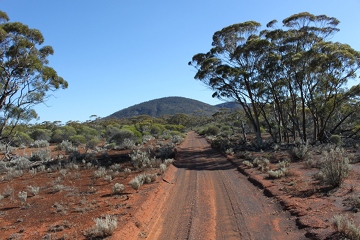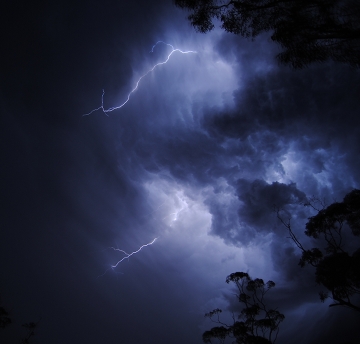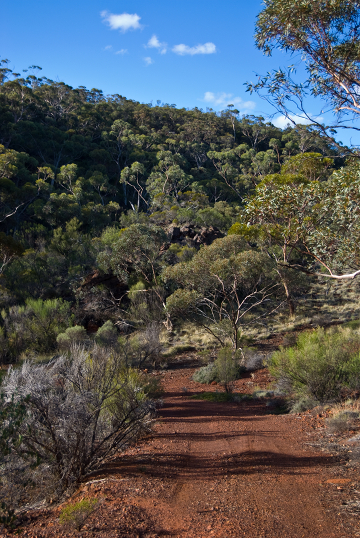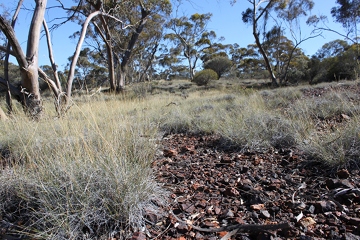Helena Aurora Range Bungalbin
Helena and Aurora Range (Bungalbin) is made up of a series of long extensive, often convoluted, hills (or ranges). The highest point is 704 m above sea level. Within Helena and Aurora Range the only hill with an official name is Bungalbin Hill, located at the south end of the range. It is the first hill you see as you drive in to Helena and Aurora Range from the south on the Mt Dimer Track (via Southern Cross and Koolyanobbing). The main area of the Helena and Aurora Range is approximately 13 km long. There is also a low range that comes in from the north-west (to very close to the main range) that is considered part of Helena and Aurora Range, having the same distinctive vegetation (predominantly eucalypts over a bunch grass Neurachne annularis) see Maps and Location.
Many people visit Helena and Aurora Range, especially on long weekends, camping near the base of the hills. Weddings have also been held at the top of Helena and Aurora Range. Many of us recognise that this range is an important part of our heritage. Views from the hill tops of Helena and Aurora Range are of a 360 degree horizon made up of Yilgarn woodlands (part of the Great Western Woodlands) and sandplains. To date very little sign of human activity such as clearing or mining can be seen. The lightening storms (with and without rain) in the area are very dramatic as seen camped near the range or from the top of the range.
Naming of the Range
The range is known as Bungalbin by the Traditional Owners of this country, the people of the Kapurn Nation (Elder, Kalamai Kapurn, Brian Champion Senior pers. com.). Bungalbin comes from their language Kalamai Kaburn (or Kalamayi Gabrun), see Traditional Owners of Range.
The range was later named by the explorer John Forrest in 1869 after Helena Aurora Monger, the daughter of John Henry Monger (known as Henry Monger) and Henrietta Joaquim Manning (Maiden name). The Geographic Names Committee (GEONOMA database) formalised the name in the 1970’s for use on maps.
Bungalbin Hill was named by the surveyor Ernest Henry Absolon using the local Kalamaia name. (S Nevill, Parks and Reserves Book 4th Edition).
Current conservation status
Currently the Helena and Aurora Range is within a Conservation Park as part of the proposed Northern Yilgarn (Mt Manning Range, Mt Elvire and Jaurdi) Conservation Reserve. The Northern Yilgarn Conservation Reserve includes at least seven BIF Ranges within four conservation parks as well as two reserves and several proposed reserves for conservation and mining. A Conservation Park is a multi land use area that allows recreation, pastoral and mining activities in conservation areas. The Northern Yilgarn Conservation Reserve includes what was historically known as the Mount Manning Reserve see Conservation History.
Plant life on Helena and Aurora Range, Bungalbin
On the range, the plant life includes Acacia shrublands and Eucalypt woodlands over extensive bunch grasslands. The main grass at Helena and Aurora Range is Neurachne annularis. It looks just like a spinifex growing in a round clump or ring, however, it is a soft grass (long-lived). On the ironstone outcrops there are two species of plant unique (endemic) to Helena and Aurora Range. One is a leafless plant with stunning pink flowers (Tetratheca aphylla subsp. aphylla) and the other is known as a Bearded Heath having white bearded flowers (Leucopogon spectabilis). Both grow in cracks within the ironstone rocks and show great tenacity in their survival, especially during the hot, dry summer months.
The Inland White Gums (Eucalyptus capillosa subsp. capillosa) are tall, majestic trees growing up the steep slopes of Helena and Aurora Range. These trees are not present on the other neighbouring BIF Ranges. The Jackson Mallee (Eucalyptus ebbanoensis) is a much smaller multi-stemmed tree, and has a white/grey smooth bark. This mallee tends to occur on the lower slopes of Helena and Aurora Range, often with another mallee species, the Rough-fruited Mallee (Eucalyptus corrugata ). Both of these mallees can also be seen on the neighbouring BIF ranges, Koolyanobbing Range and Mt Jackson Range.
For a list of plants with conservation siginificance on Helena and Aurora Range see Significant Flora List. Photos of plants on Helena and Aurora Range can be viewed in the Photo Gallery.
Animal life on Helena and Aurora Range, Bungalbin
The animals that live on Helena and Aurora Range are often well hidden, quiet and in relatively low numbers. They include many species of reptile, birds, insects and arthropods (spiders and the like) as well as mammal species. Their low activity and numbers reflects the harsh environment in which they live. The average annual rainfall is approximately 264 mm (based on rainfall records collected at Koolyanobbing, 50 km to the south-west) and includes long dry hot summers (with occasional heavy rainfalls from cyclones). When the rains do come everything bursts in to life, the plants turning more green, growing and flowering, and the animals becoming more active and initiating breeding activity. The ranges then resound with bird calls.
For a list of animals (fauna) on Helena and Aurora Range see Fauna List. The Fauna list includes birds, mammals, reptiles, amphibians and invertebrates. Photos of animals on Helena and Aurora Range can be viewed in the Photo Gallery .
Banded ironstone formation of Helena and Aurora Range, Bungalbin
The banded ironstone formation (BIF) that makes up the structure of the Helena and Aurora Ranges can be seen as weathered orange/ochre outcrops jutting out of the hills, red/orange caves set in to some of the upper southern slopes or as banded outcropping with jaspilite. There are also the low outcropping BIF rocks that form the base of some of the tracks (often banded with the red jaspilite, the ironstone being black). On the ground surface, BIF can be seen in the loose ironstone gravel and rock lying under the Eucalyptus ebbanoensis mallees (Jackson Mallee) and Eucalyptus capillosa trees (Inland White Gums) on the hill slopes.
Situated in the Great Western Woodlands
Helena and Aurora Range (Bungalbin) lies within the north-western half of the Great Western Woodlands (see Maps and Location). The Great Western Woodlands covers an area of some 16 million hectares and has been described by The Wilderness Society (TWS) as "one of the world's last Wild Places" and "...the largest and healthiest temperate woodlands left on Earth ...". The high heritage values of this area are described in a 2008 TWS publication "The extraordinary nature of The Great Western Woodlands". The high value of this area is due to the fact that it has not been cleared, its vast size, and the magnificent open woodlands that this land and rainfall supports, with its high biodiversity and near pristine condition. The BIF ranges such as Helena and Aurora Range emerge from these woodlands to provide us with an opportunity to scale their slopes and take in the breath taking beauty of this pristine land, its ancient history and the wildlife and plant life it supports, inviting us to spend some time with ourselves, nature and the land (planet earth) we were born to.
Many different groups support the care and conservation of the Great Western Woodland. Active organisations include the PEW Environment Group, The Nature Conservancy, Gondwana Link and The Wilderness Society. They see the Great Western Woodlands as an opportunity to maintain a large healthy ecosystem and are working towards an active management plan with input from stakeholders in mining, pastoralism, tourism, local and state government, traditional owners and conservation groups.
References
- Bureau of Meteorology website January 2012.
- DEC NatureMap(now DPaW NatureMap)
- Explorer Series Western Australia No. 4
- Family Search International Genealogical Index v50
- 4WD days in the Goldfields of WA 2nd Edition
- Nevill S (2011) Travellers guide to the Parks & Reserves of Western Australia, 4th Edition. Simon Nevill Publications
- Northern Yilgarn (Mt Manning Range, Mt Elvire, and Jaurdi) Conservation Reserves Management Plan Issues paper, March 2008 (Ian Elliot, pers comm. 2006)
- Watson A, Judd S, Watson J, Lam A and Mackenzie D (2008) The extraordinary nature of The Great Western Woodlands. The Wilderness Society of WA Inc.




